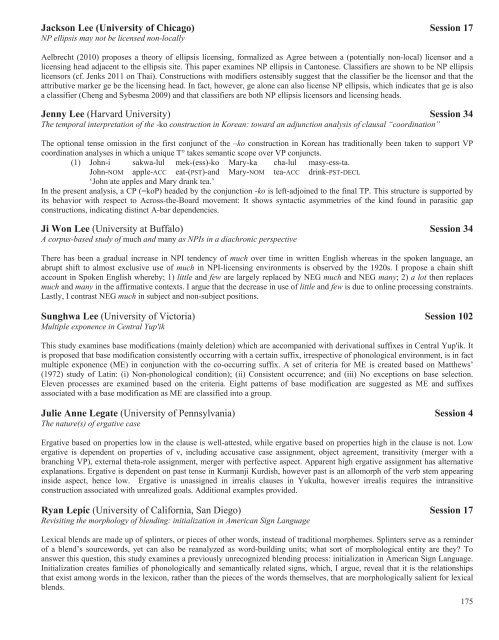here - Linguistic Society of America
here - Linguistic Society of America
here - Linguistic Society of America
Create successful ePaper yourself
Turn your PDF publications into a flip-book with our unique Google optimized e-Paper software.
Jackson Lee (University <strong>of</strong> Chicago) Session 17NP ellipsis may not be licensed non-locallyAelbrecht (2010) proposes a theory <strong>of</strong> ellipsis licensing, formalized as Agree between a (potentially non-local) licensor and alicensing head adjacent to the ellipsis site. This paper examines NP ellipsis in Cantonese. Classifiers are shown to be NP ellipsislicensors (cf. Jenks 2011 on Thai). Constructions with modifiers ostensibly suggest that the classifier be the licensor and that theattributive marker ge be the licensing head. In fact, however, ge alone can also license NP ellipsis, which indicates that ge is alsoa classifier (Cheng and Sybesma 2009) and that classifiers are both NP ellipsis licensors and licensing heads.Jenny Lee (Harvard University) Session 34The temporal interpretation <strong>of</strong> the -ko construction in Korean: toward an adjunction analysis <strong>of</strong> clausal “coordination”The optional tense omission in the first conjunct <strong>of</strong> the –ko construction in Korean has traditionally been taken to support VPcoordination analyses in which a unique T° takes semantic scope over VP conjuncts.(1) John-i sakwa-lul mek-(ess)-ko Mary-ka cha-lul masy-ess-ta.John-NOM apple-ACC eat-(PST)-and Mary-NOM tea-ACC drink-PST-DECL‘John ate apples and Mary drank tea.’In the present analysis, a CP (=koP) headed by the conjunction -ko is left-adjoined to the final TP. This structure is supported byits behavior with respect to Across-the-Board movement: It shows syntactic asymmetries <strong>of</strong> the kind found in parasitic gapconstructions, indicating distinct A-bar dependencies.Ji Won Lee (University at Buffalo) Session 34A corpus-based study <strong>of</strong> much and many as NPIs in a diachronic perspectiveT<strong>here</strong> has been a gradual increase in NPI tendency <strong>of</strong> much over time in written English w<strong>here</strong>as in the spoken language, anabrupt shift to almost exclusive use <strong>of</strong> much in NPI-licensing environments is observed by the 1920s. I propose a chain shiftaccount in Spoken English w<strong>here</strong>by; 1) little and few are largely replaced by NEG much and NEG many; 2)alotthen replacesmuch and many in the affirmative contexts. I argue that the decrease in use <strong>of</strong> little and few is due to online processing constraints.Lastly, I contrast NEG much in subject and non-subject positions.Sunghwa Lee (University <strong>of</strong> Victoria) Session 102Multiple exponence in Central Yup'ikThis study examines base modifications (mainly deletion) which are accompanied with derivational suffixes in Central Yup'ik. Itis proposed that base modification consistently occurring with a certain suffix, irrespective <strong>of</strong> phonological environment, is in factmultiple exponence (ME) in conjunction with the co-occurring suffix. A set <strong>of</strong> criteria for ME is created based on Matthews’(1972) study <strong>of</strong> Latin: (i) Non-phonological condition); (ii) Consistent occurrence; and (iii) No exceptions on base selection.Eleven processes are examined based on the criteria. Eight patterns <strong>of</strong> base modification are suggested as ME and suffixesassociated with a base modification as ME are classified into a group.Julie Anne Legate (University <strong>of</strong> Pennsylvania) Session 4The nature(s) <strong>of</strong> ergative caseErgative based on properties low in the clause is well-attested, while ergative based on properties high in the clause is not. Lowergative is dependent on properties <strong>of</strong> v, including accusative case assignment, object agreement, transitivity (merger with abranching VP), external theta-role assignment, merger with perfective aspect. Apparent high ergative assignment has alternativeexplanations. Ergative is dependent on past tense in Kurmanji Kurdish, however past is an allomorph <strong>of</strong> the verb stem appearinginside aspect, hence low. Ergative is unassigned in irrealis clauses in Yukulta, however irrealis requires the intransitiveconstruction associated with unrealized goals. Additional examples provided.Ryan Lepic (University <strong>of</strong> California, San Diego) Session 17Revisiting the morphology <strong>of</strong> blending: initialization in <strong>America</strong>n Sign LanguageLexical blends are made up <strong>of</strong> splinters, or pieces <strong>of</strong> other words, instead <strong>of</strong> traditional morphemes. Splinters serve as a reminder<strong>of</strong> a blend’s sourcewords, yet can also be reanalyzed as word-building units; what sort <strong>of</strong> morphological entity are they? Toanswer this question, this study examines a previously unrecognized blending process: initialization in <strong>America</strong>n Sign Language.Initialization creates families <strong>of</strong> phonologically and semantically related signs, which, I argue, reveal that it is the relationshipsthat exist among words in the lexicon, rather than the pieces <strong>of</strong> the words themselves, that are morphologically salient for lexicalblends.175
















